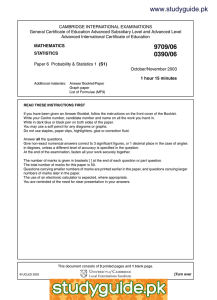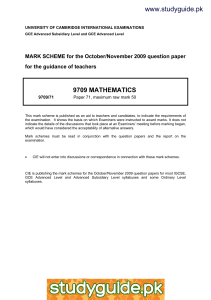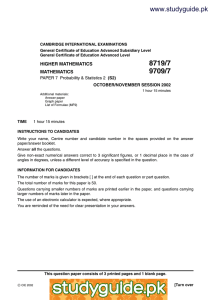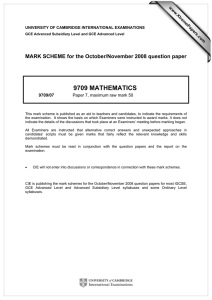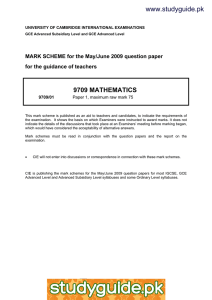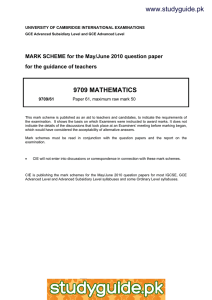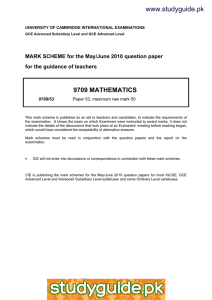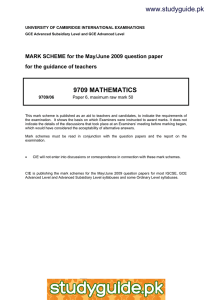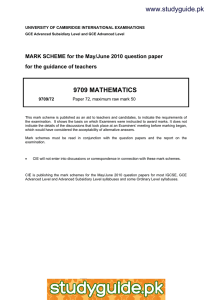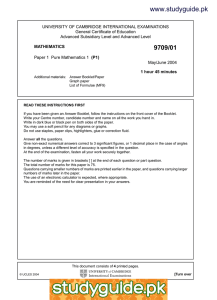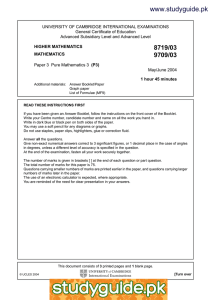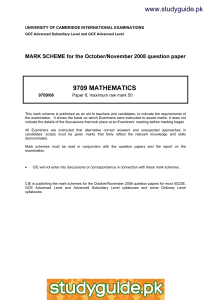www.studyguide.pk 9709 MATHEMATICS
advertisement
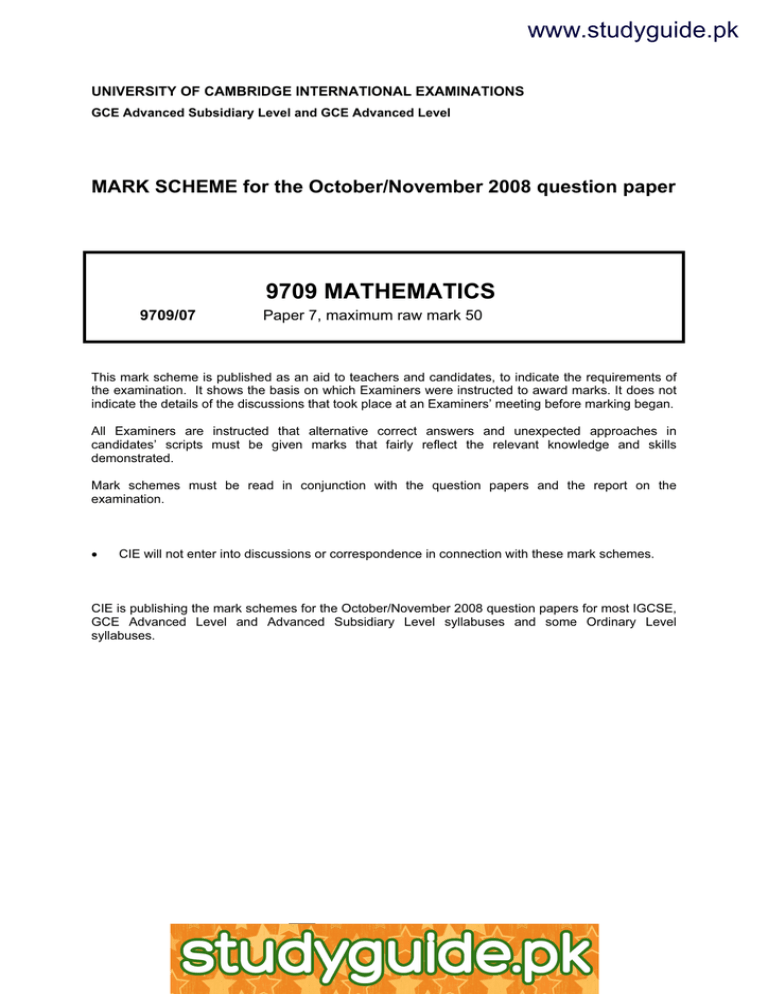
www.studyguide.pk UNIVERSITY OF CAMBRIDGE INTERNATIONAL EXAMINATIONS GCE Advanced Subsidiary Level and GCE Advanced Level MARK SCHEME for the October/November 2008 question paper 9709 MATHEMATICS 9709/07 Paper 7, maximum raw mark 50 This mark scheme is published as an aid to teachers and candidates, to indicate the requirements of the examination. It shows the basis on which Examiners were instructed to award marks. It does not indicate the details of the discussions that took place at an Examiners’ meeting before marking began. All Examiners are instructed that alternative correct answers and unexpected approaches in candidates’ scripts must be given marks that fairly reflect the relevant knowledge and skills demonstrated. Mark schemes must be read in conjunction with the question papers and the report on the examination. • CIE will not enter into discussions or correspondence in connection with these mark schemes. CIE is publishing the mark schemes for the October/November 2008 question papers for most IGCSE, GCE Advanced Level and Advanced Subsidiary Level syllabuses and some Ordinary Level syllabuses. www.xtremepapers.net www.studyguide.pk Page 2 Mark Scheme GCE A/AS LEVEL – October/November 2008 Syllabus 9709 Paper 07 Mark Scheme Notes Marks are of the following three types: M Method mark, awarded for a valid method applied to the problem. Method marks are not lost for numerical errors, algebraic slips or errors in units. However, it is not usually sufficient for a candidate just to indicate an intention of using some method or just to quote a formula; the formula or idea must be applied to the specific problem in hand, e.g. by substituting the relevant quantities into the formula. Correct application of a formula without the formula being quoted obviously earns the M mark and in some cases an M mark can be implied from a correct answer. A Accuracy mark, awarded for a correct answer or intermediate step correctly obtained. Accuracy marks cannot be given unless the associated method mark is earned (or implied). B Mark for a correct result or statement independent of method marks. • When a part of a question has two or more "method" steps, the M marks are generally independent unless the scheme specifically says otherwise; and similarly when there are several B marks allocated. The notation DM or DB (or dep*) is used to indicate that a particular M or B mark is dependent on an earlier M or B (asterisked) mark in the scheme. When two or more steps are run together by the candidate, the earlier marks are implied and full credit is given. • The symbol √ implies that the A or B mark indicated is allowed for work correctly following on from previously incorrect results. Otherwise, A or B marks are given for correct work only. A and B marks are not given for fortuitously "correct" answers or results obtained from incorrect working. • Note: B2 or A2 means that the candidate can earn 2 or 0. B2/1/0 means that the candidate can earn anything from 0 to 2. The marks indicated in the scheme may not be subdivided. If there is genuine doubt whether a candidate has earned a mark, allow the candidate the benefit of the doubt. Unless otherwise indicated, marks once gained cannot subsequently be lost, e.g. wrong working following a correct form of answer is ignored. • Wrong or missing units in an answer should not lead to the loss of a mark unless the scheme specifically indicates otherwise. • For a numerical answer, allow the A or B mark if a value is obtained which is correct to 3 s.f., or which would be correct to 3 s.f. if rounded (1 d.p. in the case of an angle). As stated above, an A or B mark is not given if a correct numerical answer arises fortuitously from incorrect working. For Mechanics questions, allow A or B marks for correct answers which arise from taking g equal to 9.8 or 9.81 instead of 10. © UCLES 2008 www.xtremepapers.net www.studyguide.pk Page 3 Mark Scheme GCE A/AS LEVEL – October/November 2008 Syllabus 9709 Paper 07 The following abbreviations may be used in a mark scheme or used on the scripts: AEF Any Equivalent Form (of answer is equally acceptable) AG Answer Given on the question paper (so extra checking is needed to ensure that the detailed working leading to the result is valid) BOD Benefit of Doubt (allowed when the validity of a solution may not be absolutely clear) CAO Correct Answer Only (emphasising that no "follow through" from a previous error is allowed) CWO Correct Working Only - often written by a ‘fortuitous' answer ISW Ignore Subsequent Working MR Misread PA Premature Approximation (resulting in basically correct work that is insufficiently accurate) SOS See Other Solution (the candidate makes a better attempt at the same question) SR Special Ruling (detailing the mark to be given for a specific wrong solution, or a case where some standard marking practice is to be varied in the light of a particular circumstance) Penalties MR -1 A penalty of MR -1 is deducted from A or B marks when the data of a question or part question are genuinely misread and the object and difficulty of the question remain unaltered. In this case all A and B marks then become "follow through √" marks. MR is not applied when the candidate misreads his own figures - this is regarded as an error in accuracy. An MR -2 penalty may be applied in particular cases if agreed at the coordination meeting. PA -1 This is deducted from A or B marks in the case of premature approximation. The PA 1 penalty is usually discussed at the meeting. © UCLES 2008 www.xtremepapers.net www.studyguide.pk Page 4 1 (i) Mark Scheme GCE A/AS LEVEL – October/November 2008 Not all totals have the same probability e.g. P(7) = 6/36, P(4) = 3/36 (ii) Any valid method e.g. using pieces of paper, calculator, random number tables 2 H0: µ = 42 H1: µ ≠ 42 Test statistic z = 35 − 42 (15.7 / 3) = –0.772 − 0.772 < 1.645 Teacher’s estimate can be accepted. OR: 42 ±1.645(15.7/√3) (27.1, 56.9) 27.1< 35 < 56.9 Teacher’s estimate can be accepted. 3 4 2T ~ N(72, 2 × 1.6)2 10C ~ N(73, 10 × 0.4)2 2T – 10C ~ N(–1, 2 × 1.62 + 10 × 0.42) ~ N(–1, 6.72) 0 − (−1) P((2T – 10C)> 0) = 1 – Φ 6.72 = 1 – Φ(0.3857) = 1 – 0.650 = 0.350 (i) x = 4.27 s2 = 1 = 0.00793 = (4.25, 4.29) (iii) 9 [2] B1 B1 Paper 07 Or equivalent Any example to correctly justify their statement above Valid idea [2] Method of choosing – full description B1 Correct H0 and H1 M1 Standardising attempt, must have A1 Correct test statistic (±) M1 Correct comparison. ± 1.645 seen or ±1.64 or ±1.65 must compare + with + or – with – (or 1.282 if onetail test being followed) Correct conclusion. (ft) No contradictions. A1ft [5] M1 A1 M1 A1ft Correct comparison Correct conclusion B1 B1 Correct mean ±(72–73) 2 × 1.62 + 10 × 0.42 or 6.72 seen M1 Consideration of 2T – 10C and standardising, no cc, sq root M1 A1 [5] 3 used correctly Correct side (<0.5) – consistent with their working Correct answer B1 Correct mean M1 Substituting in formula from tables (or equiv) 2 555.1 2371.3 − 129 130 (ii) CI = 4.27 ± 2.17 × B1 B1 Syllabus 9709 A1 0.08905 130 [3] Correct variance Correct z used (2.169–2.171) B1 M1 A1 [3] Correct form of expression 130 in denominator Correct answer (cwo) B1 [1] c.a.o © UCLES 2008 www.xtremepapers.net www.studyguide.pk Page 5 5 Mark Scheme GCE A/AS LEVEL – October/November 2008 Paper 07 (i) P(Type I error) = P(1 or more) = 0.0202 M1 A1 [2] Identifyng correct probability Correct answer (condone Poisson approx) (ii) P(Type II error) = P(0) under H1 = (1 – 0.0024)12 = 0.972 B1 M1 A1 [3] Identifying correct probability Attempt to find their prob using 0.0024 Correct final answer (condone Poisson approx) (iii) Poisson approximation λ = 0.288 B1 For 0.0024 × 120 in a Poisson expression M1 Poisson expression for P(2), any mean A1 [3] Correct answer SR Use of Binomial giving final answer of 0.0310 scores B1 0.288 2 P(2) = e −0.288 2 = 0.0311 6 Syllabus 9709 (i) λ = 1.15 B1 (ii) P(0) × P(>0) = e −1.15 × (1 − e −1.15 ) = 0.3166 × 0.6833 M1 = 0.216 60 × 2.3 = 1.53(3) 90 P(at least 1) = 1 – P(0) = 1 – e–1.533 = 0.784 (iii) λ = (iv) λ = 4.1 P(at least 3) = 1 – P(0, 1, 2) = 1 – e − 4.1 1 + 4.1 + = 1 – 0.224 = 0.776 4. 12 2 [1] A1 [2] Multiplying two Poisson probs meant to be no goals in first half and something in second half Correct answer B1 New mean M1 A1 [3] Attempt at finding 1 – P(0) with new mean Correct answer (cwo) B1 New mean (or 6 correct combinations 0,0 1,0 2,0 etc) M1 Using Poisson with new mean (or combinations) to find P (≥ 3) condone 1 end error A1 [3] Correct answer © UCLES 2008 www.xtremepapers.net www.studyguide.pk Page 6 4 7 (i) ∫ kt Mark Scheme GCE A/AS LEVEL – October/November 2008 0.5 dt = 1 Syllabus 9709 Paper 07 M1 Equating to 1 and attempting to integrate (ignore limits) A1 Correct integration ignore limits A1 [3] Correct answer legitimately obtained 1 4 2kt 1.5 =1 3 1 16k − 2k =1 3 3 k = 3/14 AG 4 (ii) mean time = 4 1.5 ∫ kt dt 1 = 2.66 hours A1 Correct integration and correct limits M1 Substituting correct limits in their integration (need not be correct) A1 [4] Correct answer m 0.5 ∫ kt dt = 0.5 m (iv) ∫ kt 1 1 − = 0.5 7 7 m = 2.73 hours 2.726 ∫ Attempt to evaluate kt 0.5 dt (accept k missing) M1 1 1.5 0.5 2.657 = 0.0243 dt (ignore limits) 1 m (iii) 1.5 Attempting to evaluate 4 64k 2k 2 − = kt 2.5 = 5 5 1 5 ∫ kt M1 Attempt to solve an equation in m, = 0.5 M1 A1 2.7261.5 2.6571.5 dt = − 7 7 M1 A1 [3] Correct answer (aef) Attempt to integrate using their mean and median as limits [2] Correct answer accept between 0.0241 and 0.0257 © UCLES 2008 www.xtremepapers.net
